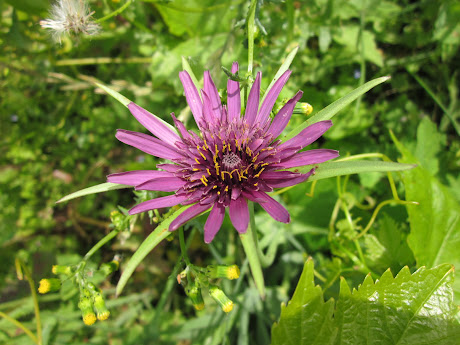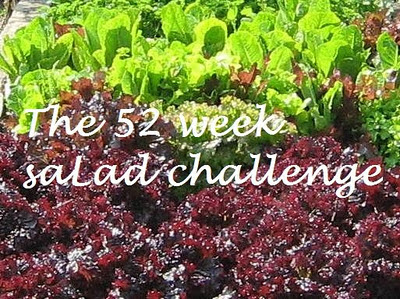Learning to Scythe
Those of you watching The Village on Sunday evenings will have seen quite a bit of scything lately courtesy of John Simm. So, it was with great timing Beth Tilston had kindly offered to teach me to scythe on Saturday. The picture shows Beth in action in the sunshine. Yay, sunshine!
I'd always thought scything must be a difficult thing to do. Well, it's not difficult, but to do it well takes some practice. After Beth's lesson I'm confident I'll get there. The key is to keep the blade low on the ground and to keep the arms relatively close to the body (as you can see in the photo) when making the cutting swing. This conserves energy (and muscles!) and makes it easier to keep the blade in the right position. Hacking away isn't the right thing to do!
The scythe is easy to assemble and much lighter than I was expecting. Though of course a light scythe makes sense when you've got a meadow to mow. We scythed in three main areas. The first was newly emergent grass (not much of this because of the recent cold weather), which was akin to trimming an area that's looked after regularly or clearing an area which has lots of fresh growth.
The second was topping (as shown in the photo) which clears off the top layer of dead grass ready to trim back fresh growth. This technique will be useful on my allotment, not only for clearing neglected areas, but also for clearing back the mounds of grass which typically appear over the winter and a regular lawn mower really struggles with. I also used this technique to clear the grass surrounding the raised beds you can just see to the right of the photo. A smaller blade was used for this latter task due to the narrow space.
We also cleared an area of brambles close to the hedge you can see in the photo. It was most satisfying. It's also interesting to see how the scythe blade is used to turn over and trace the brambles to their source before chopping them off in their prime. Beth had cleared this area a couple of times last year and noted how the brambles' re-growth is getting noticeably weaker. Ha - take that you brambles! Something to remember for those coming over to us from the public land methinks.
As well as using the blade to turn over the brambles, Beth also showed me how it can be used to pile up the scythed grass or brambles ready for disposal. All this without any bending over - much easier on the back and legs :)
Beth also showed me how to sharpen the blade. This needs to be done every 10 minutes or so. I was surprised at first, but quickly realised how right she was. When you feel your technique's got a bit rubbish, then that's the time to sharpen the blade and find all is right with the world again. The blade also needs peening from time to time. This is a special kind of hammering technique which levels the blade out again into its optimum angle for scything.
I had a fab day - Beth is a great teacher and her enthusiasm for scything has taken her to many interesting places. I could tell you lots more, but they're Beth's stories to tell, not mine.
If you live in the south-east, or are visiting the Sussex area, it's well-worth checking out Beth's website for details of her courses. She teaches individually, or in groups of 6-8, so the latter's a great option if you can get a group together. It's a rural craft that's well worth reviving; it's eco-friendly and a useful technique to have in one's gardening armoury. A scythe is the ideal partner for anyone with a wildflower meadow and how about us starting a campaign for quieter lawn mowing on Sundays?
My thanks to Beth for her time and patience and to her friend Caroline for allowing us to use her smallholding for the day. She also provided the yummy wild garlic pesto and pasta we had for lunch :)
Useful links
- A great post from Beth about scything on the Guardian Gardening blog last year.
- There is just one UK supplier of the Austrian scythes we used on Saturday.
- If you're in or near Somerset on June 9th, then the West Country Scythe Festival and Green Fair looks well worth checking out.
- The Scythe Association currently has around 100 members. More are welcome :)











My father used to use a scythe. I tried it only once and found it far to heavy - either because it was an old fashioned sort, I was too short, too young or too weedy. (Probably all four.) Can imagine it's very satisfying once you've learnt to get in the swing.
ReplyDelete
DeleteA scythe is a tool which needs to be set up for the individual using it - the handles need to be in the correct place to be used efficiently and comfortably. Unfortunately this means the scythe we have is set for Compostman, and I am on the look out for another one to fit my shorter stature - I can use his, but not for very long before my back starts to ache.
Beth showed me how to set it up and it's really easy to change. The shaft (snath) should have several holes in it where the handles are fitted. The lower one is aligned with the pivot point of your leg. The upper one is around an inch above the finger tips when the elbow is rested on the lower handle - or in my case the lowest hole as my fingertips were way short of the mark!
DeleteOurs is a very old one, bought from TFSR many years ago and it is not that easy to alter "in the field" - we can set it up for him, or for me, before we go out, but not really while working
DeleteI want one of my own, anyway so will just keep looking :-)
I'm a huge fan of scything and bought myself a vintage model at a country fair last year. By the time you've plugged in the strimmer and adjusted the string, a scythe is often an easier, faster method (and certainly kinder to the neighbours' ears). Dead jealous that you've had lessons, though we seem to have worked out what to do (we'd better do a bit more sharpening, though). Have looked at peening videos online and it does look a bit fiddly. Does Beth teach you how to do that too?
ReplyDeleteI had a demonstration of one of the 2 methods, Helen. I suspect it was the fiddly method you've seen. Beth prefers using a 'peening pony' which is less fiddly and I think is like the draw horse we saw Simon using for his green woodwork at Great Dixter.
DeleteGlad you had such a great time with Beth - hoping to get her up her for a scything workshop in the summer ( if/when we get one!) You were lucky with the weather as well :-)
ReplyDeleteShe hasn't forgotten - fingers crossed it happens :)
DeleteOh what fun VP. I can see such skills coming in most useful at the allotment.
ReplyDeleteMost useful :)
DeleteHi VP - I wonder if you've heard of The Green Scythe Fair at Muchelney? This year it's being held on Sunday 9th June. I haven't been before but have heard great things! http://www.greenfair.org.uk/
ReplyDeleteHi Celia and welcome! I've linked to the Fair at the end of the post - it looks really interesting and I hope to be there :)
DeleteInteresting. Never thought of using it on brambles, and got a few..
ReplyDeleteFor me using it on the brambles was the most satisfying - I like wreaking revenge!
DeleteFascinating post ... and the pesto recipe looks yummy too!
ReplyDeleteLovely post and very informative,great to revive old techniques and keep them going.I have quite a few old tools but no scythe,shame we don't have anywhere we could use one
ReplyDeleteReally nice post and very interesting to read. The picture is really cool, looking forward to more.
ReplyDeleteLynda - the pesto was wonderful. Wild garlic is just coming into view, so time to start picking soon :)
ReplyDeleteflowerlady - with the right blade they can be used in very small spaces. I'm considering using one on my teeny tiny lawn at the moment!
Flor - thanks.
Oooh, what fun! I'd be too scared to try scything without a competent guide, but it sounds deeply satisfying, particularly when it comes to brambles. I did wield a mattock for the first time today though, and got rid of a large pampass grass very easily. I do love a good tool...
ReplyDeleteJanet - it's very satisfying indeed. I don't have a mattock, but I do have a set of Chillington hoes - they're very satisfying to use too!
ReplyDeleteJust looked "chillington hoe" up on line, so can you swap the heads around on a handle then? I have been procrastinating about getting hoe for weeding for ages now, and of course the weeds are flourishing in the warmer weather...
ReplyDeleteHi Janet - you can, though I've not done that. I've preferred to keep the head as firmly fixed on the shaft as possible as it can work loose otherwise. It's been brilliant for clearing the allotment quickly without the usual backache involved :)
ReplyDelete